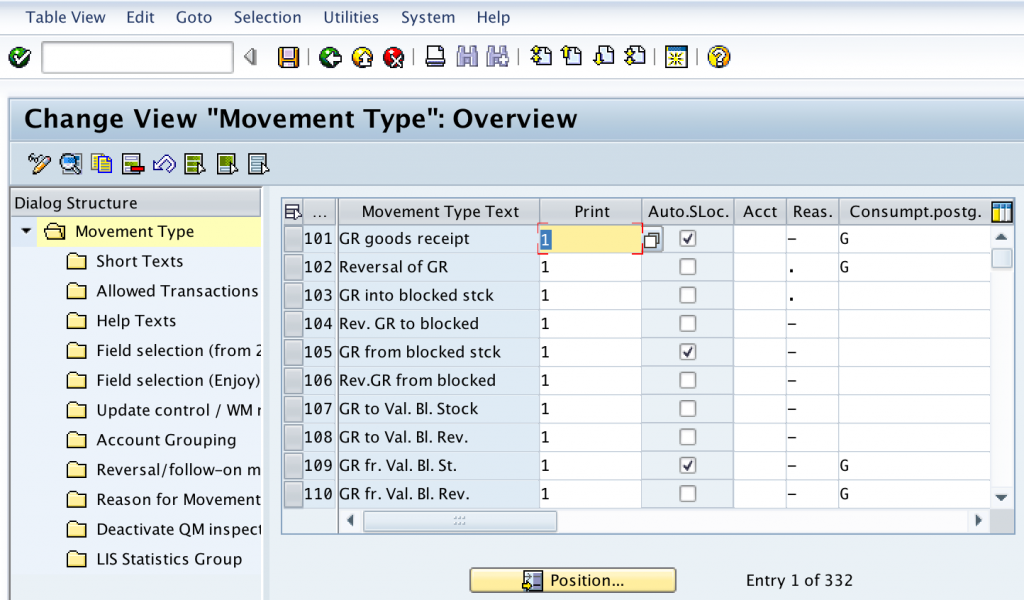Here is a fact about Movement Types, not a single stock movement can happen in SAP without it. In SAP, any stock movement represents a three-digit movement type code. Movement types are critical in any SAP transaction involving stock movement, like MIGO.
Movement types play a vital role in the following areas:
- First, SAP Screen control, meaning the 3-digit code, determines which fields you see on your screen.
- Quantity field update
- Account determination
- FI integration, where the generation of movement type triggers a FI document entry.
Table of Contents
What happens when you enter a movement in SAP?
Once you enter a movement in let’s say MIGO and save, a chain of events occurs in the system, including:
- Generation of a material document
- A financial accounting document is generated if the movement is accounting relevant.
- The stock numbers/quantities are updated in the system.
- The value of the stock is updated and its corresponding consumption accounts.
SAP Movement types examples:
Below are some examples of movement types in SAP
- A goods receipt against a purchase order or production order
- A goods issue to production
- A goods issue to cost center
- A return to vendor
- A sale to a customer
- A scrap posting
- A storage location-to-storage location transfer
- A plant-to-plant transfer
- A transfer from quality inspection stock into unrestricted stock
- A transfer from consignment stock into own stock
As you can see from the above, choosing a movement type should be considered as a vital decision upon saving the movement in the system, and you need to remember the following very important another message:
Let’s run a small scenario to have this idea stick: You received your laptops from your supplier, and you warehouse people are happy, they received a total of 100 laptops, and boom the warehouse clerk went to MIGO, did a MIGO reception against the PO, put a Q of 100, and flagged the infamous Item Ok indicator, and saved. A couple of hours later, your warehouse manager calls you and says: sorry but we made a huge mistake, we should not have received these materials, as they belong to a different PO. What do you do in this case?

In this example, you added the stock with movement type 101, the most used Movement Type for a goods receipt against a purchase order.
You have two options here; you can either:
Reverse the document that you created by mistake. To do this, go to:
MIGO – Material Document – Cancel – Insert the number you made by mistake, Press Enter, select the items you want to cancel, Post the document.
Or
Use the reversal movement type. Again, let’s go back to our example above. You received 100 laptops from your supplier, but instead of using the default movement, 101, you will need to take the reversal movement type, which is, in this case, 102.
Fact: Any movement type has a reversal of +1; the 101 (goods receipt) example has the 102 (101+1) reversal associated with it.
You can read more about movement type 101 in my dedicate post here:
/
Movement types in Warehouse Management (WM)
The use case of reversal movements is too many to specify in this article, but you can use this functionality to reverse partial quantities, which can be helpful. The difference between the two options that I just provided you is that by the Cancel option, you can only switch the total amount while you can cancel certain items by using the reversal movement.
In addition, movement types are not only used in materials management (MM), but movement types are also widely used in Warehouse Management (WM) module. Movement types in WM specify references postings with the following information:
Stock category for the quants created by the movement
Indicator controlling the creation of transfer requirements and posting a change notice.
Movement types in WM essentially control what goes out or in the warehouse and provide the following helpful info:
1. Interim storage area
2. Type of interim storage bin
3. Control indicators for processing, confirming, and printing transfer orders
4. Indicator for finding the storage type in the warehouse.
How to create a new SAP movement type
You can create or re-configure the movement types in the system however you please. However, if you have a specific case where you need to create a new procedure that does not exist in SAP, the key to take here is to copy an existing movement type instead of creating one from scratch. SAP recommends that you copy the movement type you’d like to use and use the first letter Z. You can easily mess up the settings or miss a control indicator if you create one by scratch, so please use that route instead.
However, I’d suggest that you look first at the hundreds of already pre-configured movement types in the system for all kinds, such as stock transfer, transfer posting, withdrawal, or reversal.
My recommendation, in this case, is to just configure an already set up movement for your own needs and take it as a last resort to set up your own.
Transaction Code: OMJJ or via IMG (SPRO) through the following:
Materials Management – Inventory Management and Physical Inventory – Movement Types – Copy – Change Movement Types

Another critical fact to know here is that, upon any goods movement (receipt, issue, or transfer) post in the system, two documents will be automatically be produced, and they are the following:
- Material document: Think about this one as proof that the movement has taken place and serves as a reference for downstream (three-way match) payment.
- Accounting document: A parallel document is created here with the idea that if the movement triggers a financial implication on the company, a G/L account entry is enabled. The general rule here is that there is 1:1 relationship between material and accounting document, but if the movement triggers multiple plants for example, multiple accounting documents will be created. To view these documents, use the Tcode: FB03.
Note: there are certain cases where accounting documents are not generated, for example, storage location to storage location stock transfers or intercompany stock transfers where no accounting movement has occurred to trigger a change in the material’s valuation.
Now that you have a general idea of what is movement type in SAP, let us detail some known movement types in the system:
SAP Movement Types
| Movement Type | Description |
| 101 | Goods receipt for purchase order or order |
| 103 | Goods receipt for purchase order into GR blocked stock |
| 105 | Release from GR blocked stock for purchase order |
| 121 | Subsequent adjustment for subcontracting |
| 122 | Return delivery to supplier or to production |
| 123 | Reversal of return delivery |
| 124 | Return delivery to vendor from GR blocked stock |
| 125 | Return delivery from GR blocked stock – reversal |
| 131 | Goods receipt for run schedule header |
| 141 | Goods receipt for subsequent adjustment for active ingredient |
| 161 | Return for purchase order |
| 201 | Goods issue for a cost center |
| 221 | Goods issue for a project |
| 231 | Goods issue for a customer order (without Shipping) |
| 241 | Goods issue for an asset |
| 251 | Goods issue for sales (without customer order) |
| 261 | Goods issue for an order |
| 281 | Goods issue for a network |
| 291 | Goods issue for any arbitrary account assignment |
| 301 | Transfer posting plant to plant in one step |
| 303 | Transfer posting plant to plant in two steps – removal from storage |
| 305 | Transfer posting plant to plant in two steps – placement in storage |
| 309 | Transfer posting material to material |
| 311 | Transfer posting storage location to storage location in one step |
| 313 | Stock transfer storage location to storage location in two steps – removal from storage |
| 315 | Transfer posting storage location to storage location in two steps – placement in storage |
| 317 | Creation of a structured material from constituent components (Retail) |
| 319 | Split structured material into components (Retail) |
| 321 | Transfer posting stock in quality inspection – unrestricted-use stock |
| 323 | Transfer posting storage location to storage location – stock in quality inspection |
| 325 | Transfer posting storage location to storage location – blocked stock |
| 331 | Withdrawal of sample from stock in quality inspection |
| 333 | Withdrawal of sample from unrestricted-use stock |
| 335 | Withdrawal of sample from blocked stock |
| 340 | Revaluation of batch |
| 341 | Change in status of a batch (available to unavailable) |
| 343 | Transfer posting blocked stock – unrestricted-use stock |
| 349 | Transfer posting from blocked stock to stock in quality inspection |
| 351 | Goods issue for a stock transport order (without Shipping) |
| 411 | Transfer posting of special stocks E, K, and Q to company’s own stock |
| 413 | Transfer posting to sales order stock |
| 415 | Transfer posting to project stock |
| 441 | Transfer posting non-tied to tied empties |
| 451 | Returns from customer (without Shipping) |
| 453 | Transfer posting blocked stock returns to unrestricted-use stock |
| 455 | Transfer posting storage location to storage location – blocked stock returns |
| 457 | Transfer posting blocked stock returns to quality inspection stock |
| 459 | Transfer posting blocked stock returns to blocked stock |
| 501 | Goods receipt without purchase order – unrestricted-use stock |
| 503 | Goods receipt without purchase order – stock in quality inspection |
| 505 | Goods receipt without purchase order – blocked stock |
| 511 | Free-of-charge delivery from vendor |
| 521 | Goods receipt without order – unrestricted-use stock |
| 523 | Goods receipt without order – stock in quality inspection |
| 525 | Goods receipt without order – blocked stock |
| 531 | Goods receipt from by-product from the order |
| 541 | Transfer posting unrestricted-use stock – stock of material provided to vendor |
| 543 | Consumption from stock of material provided to vendor |
| 545 | Goods receipt from by-product from subcontracting |
| 551 | Scrapping from unrestricted-use stock |
| 553 | Scrapping from stock in quality inspection |
| 555 | Scrapping from blocked stock |
| 561 | Initial entry of stock – unrestricted-use stock |
| 563 | Initial entry of stock – quality inspection |
| 565 | Initial entry of stock – blocked stock |
| 571 | Goods receipt for assembly order to unrestricted-use |
| 573 | Goods receipt for assembly order to quality inspection |
| 575 | Goods receipt for assembly order to blocked stock |
| 581 | Goods receipt of a by-product from the network |
| 601 | Goods issue for delivery (Shipping) |
| 603 | Goods issue for stock transport order (Shipping) with additional item |
| 605 | Goods receipt for a stock transport order (Shipping) with additional item |
| 621 | Transfer posting unrestricted-use – returnable packaging (Shipping) |
| 623 | Goods issue from returnable packaging stock at customer (Shipping) |
| 631 | Transfer posting unrestricted use – customer consignment stock (Shipping) |
| 633 | Goods issue from customer consignment (Shipping) |
| 641 | Goods issue for a stock transport order (Shipping), outbound delivery |
| 643 | Goods issue for a cross-company, stock transfer order with billing and invoice |
| 645 | Goods issue for a cross-company, order in one step (Shipping) |
| 647 | Goods issue for a stock transport order in one step |
| 651 | Returns from customer (Shipping) |
| 653 | Returns from customer (Shipping) to unrestricted-use stock |
| 655 | Returns from customer (Shipping) to stock in quality inspection |
| 657 | Returns from customer (Shipping) to blocked stock |
| 661 | Returns to vendor via Shipping |
| 671 | Returns for stock transport order via Shipping |
| 673 | Returns for cross-company stock transport order |
| 675 | Returns for cross-company stock transport order |
| 677 | Returns for stock transport order in one step (Shipping) |
| 701 | Inventory differences in unrestricted-use stock (MM-IM) |
| 703 | Inventory differences in quality inspection stock (MM-IM) |
| 707 | Inventory differences in blocked stock (MM-IM) |
| 711 | Inventory differences in unrestricted-use stock (LE-WM) |
| 713 | Inventory differences in quality inspection stock (LE-WM) |
| 715 | Inventory differences in blocked stock returns (LE-WM) |
| 717 | Inventory differences in blocked stock (LE-WM) |
| 721 | Sales value receipt – not affecting margins (Retail) |
| 731 | Sales value receipt – affecting margins (Retail) |
Conclusion
Always remember that any of these movements above are reversed by adding +1
I hope this brief introduction of movement types in SAP gave you a better idea of its usecase, and as always, if you have any comments or requests, please do not hesitate to drop them down below! One more note, if you like our articles, why don’t you join our mailing list? We take a very serious approach with our quality content, and our goal is to inform interested readers like you on all things related to SAP and spend management.
Make sure to check our companion MM link regarding SAP MM Tables!
References
Movement types, https://wiki.scn.sap.com/wiki/display/ERPLO/Movement+types
Inventory Management and Optimization in SAP ERP, Elke Roettig
- Overview of the Material Master in SAP S/4HANA - January 2, 2024
- SAP FICO TRANSACTION CODES (MOST COMMON) - December 24, 2023
- Best SAP S/4HANA MM Books for Beginners and Advanced Learners - November 25, 2023





0 Comments